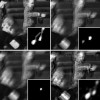Free Online Productivity Tools
i2Speak
i2Symbol
i2OCR
iTex2Img
iWeb2Print
iWeb2Shot
i2Type
iPdf2Split
iPdf2Merge
i2Bopomofo
i2Arabic
i2Style
i2Image
i2PDF
iLatex2Rtf
Sci2ools
CVPR
2009
IEEE
2009
IEEE
Understanding and evaluating blind deconvolution algorithms
Blind deconvolution is the recovery of a sharp version of
a blurred image when the blur kernel is unknown. Recent
algorithms have afforded dramatic progress, yet many aspects
of the problem remain challenging and hard to understand.
The goal of this paper is to analyze and evaluate recent
blind deconvolution algorithms both theoretically and
experimentally. We explain the previously reported failure
of the naive MAP approach by demonstrating that it mostly
favors no-blur explanations. On the other hand we show
that since the kernel size is often smaller than the image
size a MAP estimation of the kernel alone can be well constrained
and accurately recover the true blur.
The plethora of recent deconvolution techniques makes
an experimental evaluation on ground-truth data important.
We have collected blur data with ground truth and compared
recent algorithms under equal settings. Additionally,
our data demonstrates that the shift-invariant blur assumption
made by most al...
| Added | 04 May 2009 |
| Updated | 10 Dec 2009 |
| Type | Conference |
| Year | 2009 |
| Where | CVPR |
| Authors | Anat Levin, Yair Weiss, Frédo Durand, William T. Freeman |
Comments (0)

